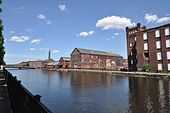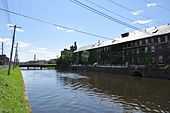Holyoke Canal System
|
Holyoke Canal System | |
.jpg) | |
|
Holyoke Canal System | |
| Location | Holyoke, Massachusetts |
|---|---|
| Built | 1847 |
| Architect | Multiple |
| Architectural style | No Style Listed |
| Governing body | Private |
| NRHP Reference # | 80000473 [1] |
| Added to NRHP | December 3, 1980 |
The Holyoke Canal System is a system of Power Canals in Holyoke, Massachusetts. Its major canals are called the First Level Canal, Second Level Canal, and Third Level Canal.
History
The earliest predecessor to Holyoke's canals dates to 1827, when the Hadley Falls Company was established to manufacture cotton cloth. Its water-powered looms were fed from a wing dam along the Connecticut River's Great Rapids.
Today's canals began in 1848, after river measurements indicated an available water power of 6,000 cubic feet per second (170 m3/s), the equivalent of 30,000 horsepower (22,000 kW), or enough to power 450 mills. That year the company was reconstituted, with a capital stock of $4,000,000, to create a new manufacturing center based on local river power. Over the next 10 years it would build the area's dam and canal system, lay out industrial, commercial, and residential areas on its 1,100 acres (445 ha) of land, and construct and operate two cotton mills and a factory making textile machinery.
In 1848 the first timber crib dam, about 1,000 feet (300 m) in length, was constructed across the Connecticut River to divert water into the canals. It failed within hours,[2] and was replaced by a second timber dam, which in turn was replaced in 1900 by a granite-faced dam about 150 feet (46 m) downstream from its predecessor. The early canals were dug by men with picks and shovels, together with horse-drawn teams. Canal construction continued on and off until 1892.

In 1859, after the company had failed and had passed into receivership, Alfred Smith purchased at auction its hydraulic system, consisting of the dam, its gate houses, and 2.5 miles (4.0 km) of power canals with a boat lock; some 1,100 acres (445 ha) of land in Holyoke containing mills and other buildings; and the public water supply reservoir and gas plant, each with a distribution system. He formed the Holyoke Water Power Company and sold stock to investors. Over the next 30 years the company flourished, as a number of large mills were built in the area. Energy was transmitted from the waterwheels to mills via a distribution system of gears, shafts, pulleys, and belts. The canals first produced municipal electricity on October 14, 1884, from an electric generator connected to a water wheel-driven shafting in an industrial building. In 1888 this was replaced by a combination hydro and steam electric power plant on the First Level Canal.
Description
Today's canal system is 4.5 miles (7.2 km) in length on three levels. The canals are now used for electrical power generation as the water descends level by level to the river.

The First Level Canal contains 12 large gates regulating water coming into the system, each 15 feet (5 m) long by 9 feet (3 m) wide, and weighing more than four tons, and 2 smaller gates at 11 feet (3 m) by 4.5 feet (1.4 m), all powered by a water-wheel. At its origin the canal is 140 feet (43 m) wide with 22 feet (6.7 m) of water depth. It extends eastward about a thousand feet and then sweeps south for more than one mile (1.6 km) to supply the upper tier of mills.
The Second Level Canal runs parallel to the First but about 400 feet (120 m) east. It begins at its south end, and runs north for over a mile. For its first 2,000 feet (600 m), it is 140 feet (43 m) wide, then gradually narrows to 100 feet (30 m). Its average water depth is 15 feet (5 m).
The Third Level Canal begins at the south end of the Second Level, but some 12 feet (4 m) lower, and extends 3,550 feet (1,082 m). It is about 100 feet (30 m) wide and 10 feet (3 m) deep, with an average height above the river varying between 23 to 28 feet (9 m).
See also
References
| Wikimedia Commons has media related to Holyoke Canal. |
- ↑ "National Register Information System". National Register of Historic Places. National Park Service. 2007-01-23.
- ↑ Holyoke history page
- Northeastern Utility canal descriptions
- Holyoke, Massachusetts, Dam and Canals
- Hadley Falls fish passage
| ||||||||||||||||||||||||||||||||||||||||
Coordinates: 42°12′31″N 72°36′01″W / 42.2086°N 72.6002°W
